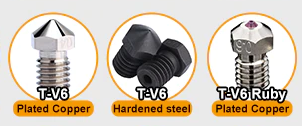When it comes to 3D printing, the material of the nozzle can have a significant impact on the quality and reliability of the final printed object. There are several different materials that are commonly used for 3D printer nozzles, each with their own unique properties and advantages.
-
Brass: Brass is one of the most common materials used for 3D printer nozzles. It is a relatively inexpensive and readily available material that is easy to work with. Brass nozzles are great for general-purpose printing and are suitable for most types of filament. One of the biggest advantages of brass nozzles is that they are easy to clean and maintain.
- Copper Plated: Copper-plated nozzles are more durable than standard nozzles and can handle higher temperatures. They are also more resistant to wear and tear, which means that they can last longer and require less maintenance. These are cost effective for printing with high-temperature filaments, such as ABS, ASA, PETG, and PEEK.
-
Hardened Steel: This type of nozzle is made by heat treating the steel, making it harder and more wear-resistant than regular steel nozzles. Hardened steel nozzles are suitable for printing with abrasive filaments and are known for their durability and long-lasting performance. They are also more resistant to clogging and jamming.
-
Ruby/Diamond: Ruby nozzles are made of synthetic ruby and are known for their exceptional durability and resistance to wear. They can handle high temperatures and are suitable for printing with abrasive filaments. They are also less likely to clog or jam and are easy to clean.
- Tungsten have excellent thermal conductivity and wear resistant and can handle abrasive filament. The downside is the high cost ~90-120 AUD per nozzle and due high melting point allowing clog nozzle to be clean out via torching it.
Ultimately, the best material for your 3D printer nozzle will depend on the type of filament you plan to print with and the quality of the final printed object you desire. It's always best to consult with the manufacturer of your 3D printer or speak with a professional to determine the best nozzle material for your needs.

